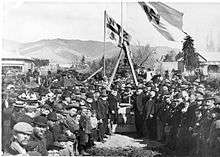List of schools in the Marlborough Region

There are 30 schools in the Marlborough Region, a region of the South Island of New Zealand. The region contains rural and small-town primary schools, a combined primary/secondary school in Rai Valley, a small secondary school in Picton, and several primary schools, an intermediate school, and two large secondary schools in Blenheim. All schools are coeducational except for the two secondary schools in Blenheim: Marlborough Girls' and Boys' Colleges.
In New Zealand schools, students begin formal education in Year 1 at the age of five.[1] Year 13 is the final year of secondary education. Years 14 and 15 refer to adult education facilities.
Most of the schools in Marlborough are state schools, which are fully funded by the government. State schools cannot charge tuition fees to New Zealand citizens and those non-citizens who are entitled to live in New Zealand indefinitely (e.g. permanent residents, residence visa holders, Australian citizens and permanent residents, refugees and protected persons), although a donation is commonly requested.[2] The only schools in the region that are not state schools are three state-integrated schools, which are former private schools with a special character based on a religious or philosophical belief that have been integrated into the state system. State-integrated schools charge "attendance dues" to cover the building and maintenance of school buildings, which are not owned by the government, but otherwise they, like state schools, cannot charge fees for tuition of domestic students but may request a donation. Two of the state-integrated schools are Catholic, while the other is an evangelical Christian school. Both state and state-integrated schools can charge fees for tuition of international students.[3] There are no private schools in Marlborough. A primary school in Koromiko closed voluntarily in December 2012 due to declining roll numbers.
Schools

The decile indicates the school community's level of socioeconomic deprivation, and is used mainly for funding purposes. A decile of 1 indicates the school's community is largely poor, while a decile of 10 indicates the school's community is largely well-off.[4] The decile ratings used here come from the Ministry of Education Te Kete Ipurangi website and from the decile change spreadsheet listed in the references. The deciles were last revised using information from the 2006 Census.[5] The roll of each school changes frequently as students start school for the first time, move between schools, and graduate. The rolls given here are those provided by the Ministry of Education, based on figures from July 2016.[6] The Ministry of Education institution number, given in the last column, links to the Te Kete Ipurangi page for each school.
Closed schools
| Name | Years | Area | Authority | Closure date | Reason for closure |
|---|---|---|---|---|---|
| Koromiko School | 1–8 | Koromiko | State | December 2012 | Closed voluntarily due to declining roll numbers[7] |
References
- General
- "Te Kete Ipurangi". New Zealand Ministry of Education. Retrieved 2008-06-08.
- "ERO school and early childhood education reports". Education Review Office. Archived from the original on 2010-06-02. Retrieved 2008-06-08.
- "Decile change 2007 to 2008 for state & state integrated schools" (XLS). New Zealand Ministry of Education. Retrieved 2008-06-08.
- Specific
- ↑ "About School: School basics". New Zealand Ministry of Education. Retrieved 2008-06-08.
- ↑ "Fees and Donations". New Zealand Ministry of Education. 2014-08-11. Retrieved 2014-08-13.
- ↑ "about NZ education". EduSearch. Archived from the original on 2010-06-02. Retrieved 2008-06-08.
- ↑ "How The Decile Is Calculated". New Zealand Ministry of Education. Retrieved 2008-06-08.
- ↑ "Reviews of Deciles - General Information". New Zealand Ministry of Education. Retrieved 2008-06-08.
- ↑ "Directory of Schools - as at 2 August 2016". New Zealand Ministry of Education. Retrieved 2016-08-16.
- ↑ Nicoll, Jared (2012-12-06). "Koromiko loses its school". The Marlborough Express. Retrieved 2013-09-17.